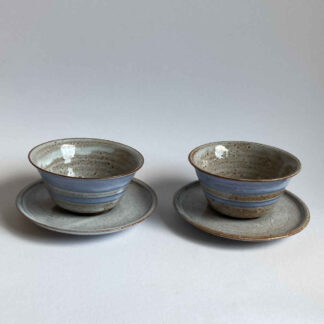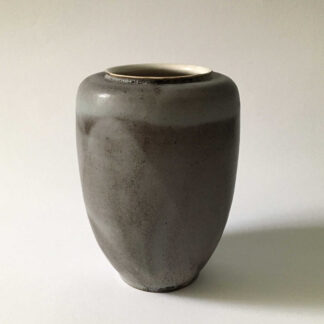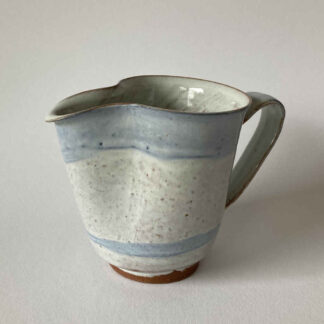Description
Type: Studio Pottery
Design: probably Marguerite Friedlaender-Wildenhain [attributed], maybe Franz Wildenhain [attributed]
Carrying out: Studio “Het Kruikje” [attributed]
Object: milk jug
Dimensions: height: 9.3 cm, width: 12.5 cm
Shard: reddish brown
Surface: white and light blue
Year of Manufacture: 1930s/1940s
Condition: one big a small several chips at the spout, repaired using the Gintsugi repair method with silver lacquer.
Signature/mark: without
Details:
The milk jug is unsigned, i.e. it has neither a signature nor a mark, but according to the previous owner it comes from a larger context of service pieces, which also included ceramics marked Het Kruikje. The owner previous to the previous owner of the milk jug was a collector from Holland who had acquired the ceramics from an elderly gentleman. The parents of this elderly gentleman had had an arts and crafts business in the Netherlands in the pre-war period and had carried Het Kruikje ceramics.
The extremely thin rim of the milk jug also speak for a ceramic from the Het Kruikje workshop, as these thin rims are typical for pieces from the Bauhaus pottery in Dornburg, where Marguerite Friedlaender-Wildenhain and Franz Rudolf Wildenhain learned as Bauhaus students. Otto Lindig, who was also a Bauhaus student at the Bauhaus pottery, also used these thin rims in his ceramics.
The shape and glaze of the milk jug were probably designed by Marguerite Friedlaender-Wildenhain. However, it is also possible that it was designed by her husband Franz Rudolf Wildenhain (Frans Wildenhain). In addition to Marguerite Friedlaender-Wildenhain and Franz Rudolf Wildenhain, employees and apprentices also worked in the Het Kruikje workshop, so it is difficult to say who turned and glazed the milk jug.
Since the arts and crafts shop began to include ceramics from Het Kruikje in its assortment around 1938/1939, the dating 1930s/1940s seems to be appropriate.
In this video you can see jugs with similar wide spouts, but from the post-war period from the Marguerite Wildenhain workshop “Pond Farm Pottery” in California (USA).



![Milk jug restored with gintsugi by Het Kruikje (Marguerite Friedlaender-Wildenhain) [attributed] – Studio Pottery](https://www.robertzueblin.com/wp-content/uploads/het-kruikje-marguerite-friedlaender-franz-wildenhain-studio-pottery-milk-jug-gintsugi-photo-title.jpg)
![Side of the milk jug restored with gintsugi by Het Kruikje (Marguerite Friedlaender-Wildenhain) [attributed] – Studio Pottery](https://www.robertzueblin.com/wp-content/uploads/het-kruikje-marguerite-friedlaender-franz-wildenhain-studio-pottery-milk-jug-gintsugi-side-1.jpg)
![Another view of the milk jug restored with gintsugi by Het Kruikje (Marguerite Friedlaender-Wildenhain) [attributed] – Studio Pottery](https://www.robertzueblin.com/wp-content/uploads/het-kruikje-marguerite-friedlaender-franz-wildenhain-studio-pottery-milk-jug-gintsugi-side-2.jpg)
![Handle of the milk jug restored with gintsugi by Het Kruikje (Marguerite Friedlaender-Wildenhain) [attributed] – Studio Pottery](https://www.robertzueblin.com/wp-content/uploads/het-kruikje-marguerite-friedlaender-franz-wildenhain-studio-pottery-milk-jug-gintsugi-side-3.jpg)
![Another side of the milk jug restored with gintsugi by Het Kruikje (Marguerite Friedlaender-Wildenhain) [attributed] – Studio Pottery](https://www.robertzueblin.com/wp-content/uploads/het-kruikje-marguerite-friedlaender-franz-wildenhain-studio-pottery-milk-jug-gintsugi-side-4.jpg)
![Frontal view of the milk jug restored with gintsugi by Het Kruikje (Marguerite Friedlaender-Wildenhain) [attributed] – Studio Pottery](https://www.robertzueblin.com/wp-content/uploads/het-kruikje-marguerite-friedlaender-franz-wildenhain-studio-pottery-milk-jug-gintsugi-side-5.jpg)
![View from above of the milk jug restored with gintsugi by Het Kruikje (Marguerite Friedlaender-Wildenhain) [attributed] – Studio Pottery](https://www.robertzueblin.com/wp-content/uploads/het-kruikje-marguerite-friedlaender-franz-wildenhain-studio-pottery-milk-jug-gintsugi-from-above.jpg)
![Gintsugi-repair of the milk jug by Het Kruikje (Marguerite Friedlaender-Wildenhain) [attributed] – Studio Pottery](https://www.robertzueblin.com/wp-content/uploads/het-kruikje-marguerite-friedlaender-franz-wildenhain-studio-pottery-milk-jug-gintsugi-repair-1.jpg)
![View from below of the gintsugi-repair of the milk jug by Het Kruikje (Marguerite Friedlaender-Wildenhain) [attributed] – Studio Pottery](https://www.robertzueblin.com/wp-content/uploads/het-kruikje-marguerite-friedlaender-franz-wildenhain-studio-pottery-milk-jug-gintsugi-repair-2.jpg)
![Another view of the Gintsugi-repair of the milk jug by Het Kruikje (Marguerite Friedlaender-Wildenhain) [attributed] – Studio Pottery](https://www.robertzueblin.com/wp-content/uploads/het-kruikje-marguerite-friedlaender-franz-wildenhain-studio-pottery-milk-jug-gintsugi-repair-3.jpg)
![Basis of the milk jug restored with gintsugi by Het Kruikje (Marguerite Friedlaender-Wildenhain) [attributed] – Studio Pottery](https://www.robertzueblin.com/wp-content/uploads/het-kruikje-marguerite-friedlaender-franz-wildenhain-studio-pottery-milk-jug-gintsugi-above.jpg)



